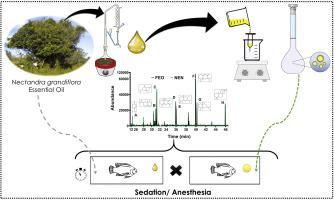Aquaculture ( IF 4.5 ) Pub Date : 2021-07-07 , DOI: 10.1016/j.aquaculture.2021.737146 Patrícia Rodrigues 1 , Fabíola Tonelli Ferrari 2 , Luísa Barichello Barbosa 2 , Andressa Righi 3 , Luciane Laporta 3 , Quelen Iane Garlet 1 , Bernardo Baldisserotto 1 , Berta Maria Heinzmann 2

|
Nectandra grandiflora essential oil has become an alternative to synthetic anesthetics and sedation in fish. However, essential oil volatility, light sensitivity, and low water-solubility may limit its use in the fish farm. To overcome these drawbacks, we developed a new nanoemulsion product that may be applied as an anesthetic. We evaluated the anesthetic property and safety of free essential oil (FEO) and its nanoemulsion (NEN) for Nile tilapia (Oreochromis niloticus). Formulations were made using the spontaneous emulsification process, and stability was tested for NEN and FEO at 4, 25, and 40 °C for 90 days. The NEN contained 95% of FEO, the major compounds remained stable up to 60 days, and the NEN protected the active substances at all temperatures. Fish behavior was observed during a bath with FEO and NEN 3–300 mg/L concentrations for 30 min. The difference between sedated and anesthetized fish was detected by their swimming behavior and response to stimuli on the caudal peduncle. Behavior score, survival, or adverse effects were accessed with 10 and 30 mg/L concentrations of FEO and NEN during 24 h exposure and 72 h recovery. Only 100 mg/L of NEN induced anesthesia without side effects. Long-term exposure tests confirmed the 30 mg/L NEN safety, with a 100% survival rate for fish exposed to NEN and a 25.5% survival rate for fish exposed to surfactants. Therefore, this poorly water-soluble essential oil was converted into a novel sedative and anesthetic for fish through nanoemulsion. Thus, nanoemulsion protects the essential oil and improves the pharmacological activity, with the suggested use of 30 mg/L during 24 h, for sedation, and 100 mg/L, for anesthesia.
中文翻译:

纳米乳液增强麻醉活性并减少 Nectandra Grandiflora Nees 精油对鱼的副作用
Nectandra grandiflora精油已成为合成麻醉剂和鱼类镇静剂的替代品。然而,精油的挥发性、光敏感性和低水溶性可能会限制其在养鱼场中的使用。为了克服这些缺点,我们开发了一种新的纳米乳液产品,可以用作麻醉剂。我们评估了游离精油 (FEO) 及其纳米乳剂 (NEN) 对尼罗罗非鱼 ( Oreochromis niloticus)的麻醉特性和安全性. 使用自发乳化工艺制备配方,并在 4、25 和 40 °C 下测试了 NEN 和 FEO 的稳定性 90 天。NEN 含有 95% 的 FEO,主要化合物保持稳定长达 60 天,并且 NEN 在所有温度下保护活性物质。在 FEO 和 NEN 3-300 mg/L 浓度的浴中观察鱼的行为 30 分钟。镇静鱼和麻醉鱼之间的差异是通过它们的游泳行为和对尾柄刺激的反应来检测的。在 24 小时暴露和 72 小时恢复期间,使用 10 和 30 毫克/升 FEO 和 NEN 浓度评估行为评分、存活率或不良反应。仅 100 mg/L 的 NEN 诱导麻醉,无副作用。长期暴露测试证实了 30 毫克/升 NEN 的安全性,暴露于 NEN 的鱼的存活率为 100%,而 25. 暴露于表面活性剂的鱼的存活率为 5%。因此,这种水溶性差的精油通过纳米乳液被转化为一种新型的鱼类镇静剂和麻醉剂。因此,纳米乳可以保护精油并提高药理活性,建议在 24 小时内使用 30 毫克/升用于镇静,100 毫克/升用于麻醉。



























 京公网安备 11010802027423号
京公网安备 11010802027423号